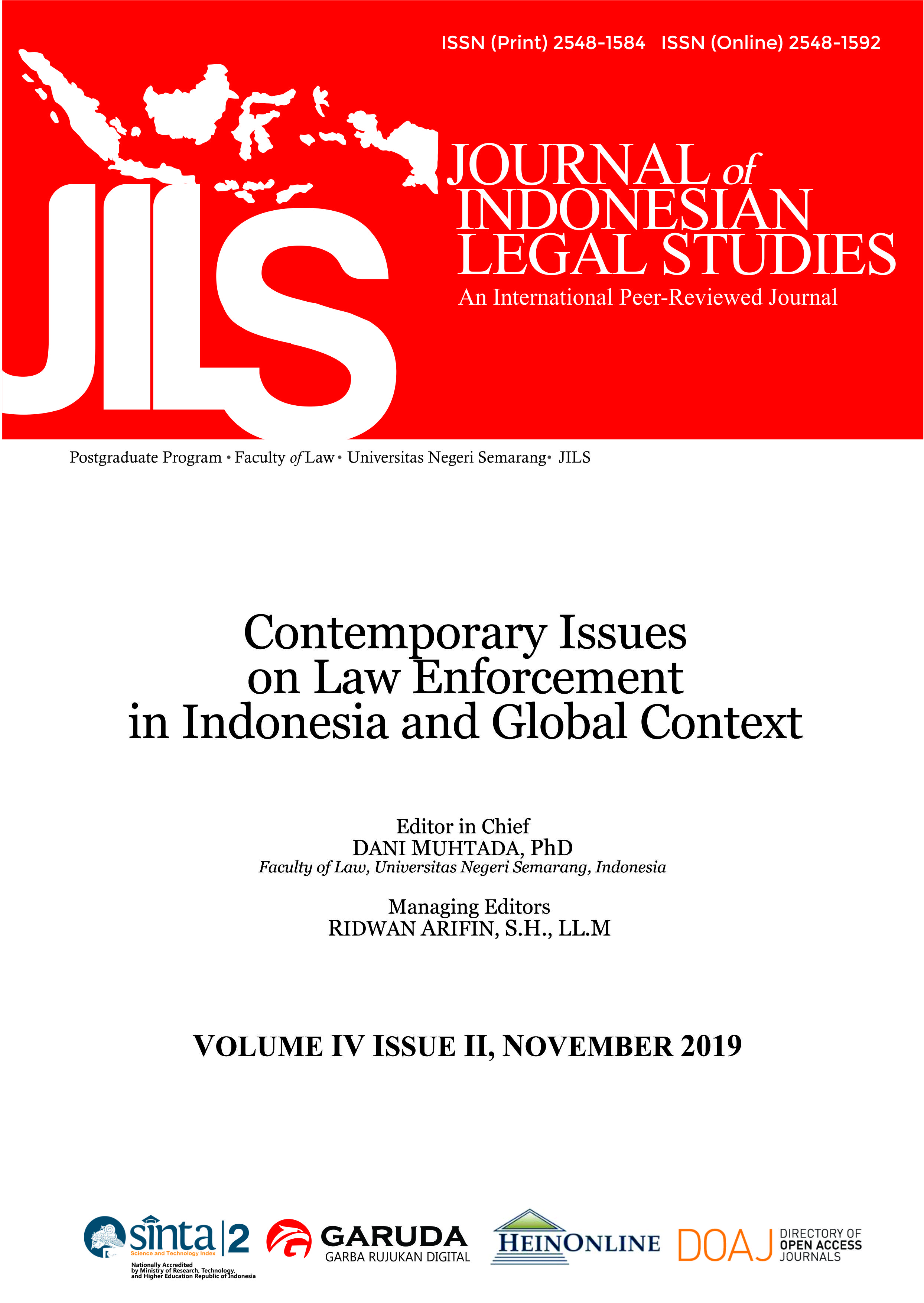The Darkest Phase for Family: Child Marriage Prevention and Its Complexity in Indonesia
Main Article Content
Abstract
The research is intended to examine how child marriage happened and the implementation of policy to prevent the child marriage. The research also examine some cases concerning to child marriage and its complex condition, especially in some area of Central Java, Indonesia. The method used to obtain the main data for the research is by interviewing and observing the main site location, at Munding Vilage Semarang Regency. Some related government offices also become one of the sources of data. The research emphasized that child marriage occurs because of the education of the bridegroom's children, the local culture of marriage at the age of the child is better than marriage in high school, economic factors of the child's family and social or environmental factors of the child. Impact of child marriages (women): vulnerable to divorce, psychological problems that are not yet stable in the management of the household, the breakup of formal education, reproductive health is not ready. The research highlighted that local culture is a challenge in opposing marriage at the age of the child. The research concluded that preventive efforts carried out by related institutions through education complaints in accordance with the main tasks of each related institution.
Article Details

This work is licensed under a Creative Commons Attribution-ShareAlike 4.0 International License.
All writings published in this journal are personal views of the authors and do not represent the views of this journal and the author's affiliated institutions. Author(s) retain copyrights under the licence of Creative Commons Attribution-ShareAlike 4.0 International (CC BY-SA 4.0).
References
Candraningrum, D. (2016). Pernikahan Anak: Status Anak Perempuan? Jurnal Perempuan untuk Pencerahan dan Kesetaraan, 21(1), 4-8. https://www.jurnalperempuan.org/uploads/1/2/2/0/12201443/jp_88-cjp__4_.pdf
Chari, A.V., Heath, R., Maertens, A., & Fatima, F. (2017. The Causal Effect of Maternal Age at Marriage on Child Wellbeing: Evidence from India. Journal of Development Economics, 127(1), 42-55. https://doi.org/10.1016/j.jdeveco.2017.02.002
Djamilah, D., & Kartikawati, R. (2014). Dampak Perkawinan Anak di Indonesia. Jurnal Studi Pemuda, 3(1), 1-16. https://doi.org/10.22146/studipemudaugm.32033
Efevbera, Y., Bhabha, J., Farmer, P.E., & Fink, G. (2017). Girl Child Marriage as a Risk Factor Foe Early Childhood Development snd Stunting. Social Science & Medicine, 185(July), 91-101. DOI: 10.1016/j.socscimed.2017.05.027
Haikal, H. (2015). Analisis Yuridis Normatif Dan Hukum Islam Terhadap Putusan Mahkamah Konstitusi Nomor 30-74/PUU-XII/2014 Tentang Batas Usia Perkawinan Anak (Perempuan). Jurnal Pembaharuan Hukum, 3(3), 348-355. http://dx.doi.org/10.26532/jph.v3i3.1363
Inayati , I.N. (2015). Perkawinan Anak Di Bawah Umur dalam Perspektif Hukum, HAM dan Kesehatan. Jurnal Bidan Midwife Journal, 1(1) , 46-53. http://jurnal.ibijabar.org/wp-content/uploads/2015/12/PERKAWINAN-ANAK-DI-BAWAH-UMUR-DALAM-PERSPEKTIF-.pdf
Julijanto, M. (2015). Dampak Pernikahan Dini dan Problematika Hukumnya. Jurnal Pendidikan Ilmu Sosial, 25(1), 62-72. DOI: https://doi.org/10.2317/jpis.v25i1.822
Kalamar, A.M., Lee-Rife, S., & Hindin, M.J. (2016). Interventions to Prevent Child Marriage Among Young People in Low and Middle Income Countries: A Systematic Review of the Published and Gray Literature. Journal of Adolescent Health, 59(3), 16-21. DOI: 10.1016/j.jadohealth.2016.06.015
Kristiana, M. D. (2019). Politics of Law on School Days Policy: Legal Reform on Indonesian Education Policy. Journal of Law and Legal Reform, 1(1), 5-24. https://doi.org/10.15294/law & legal reform.v1i1.35405
Mapreane, A . (1982). Psikologi Remaja. Surabaya: Usaha Nasional.
Mawardi, M. (2012). Problematika Perkawinan di Bawah Umur. Jurnal Analisa. 19 (2), 201-212. https://media.neliti.com/media/publications/42020-ID-problems-of-under-age-marriage.pdf
Mubasyaroh, M. (2016). Analisis Faktor Penyebab Pernikahan Dini Dan Dampaknya Bagi Pelakunya. Jurnal Pemikiran dan Penelitian Sosial Keagamaan Yudisia, 7(2), 385-411. DOI : 10.21043/yudisia.v7i2.2161
Nasrullah, M., Muazzam, S., Khosa, F., & Khan, M.M. (2017). Child Marriage and Women’s Attitude Toward Wife Beating In A Nationally Representative Sample Of Currently Married Adolescent And Young Women In Pakistan. The Royal Society of Tropical Medicine & Hygiene Int Health, 9(1), 20-28. DOI: 10.1093/inthealth/ihw047
Prayogo, B. E., Amanah, A., Pradana, T. M. W., & Rodiyah, R. (2019). Increasing Legal Capacity for Communities in the Context of Realizing a Village of Law Awareness and Child Friendly. Indonesian Journal of Advocacy and Legal Services, 1(1), 65-78. https://doi.org/10.15294/ijals.v1i1.33776
Raharjo, S. (1983). Permasalahan Hukum di Indonesia. Bandung: Alumni.
Ramadhita, R. (2014). Diskresi Hakim: Pola Penyelesaian Kasus Dispensasi Perkawinan. De Jure: Jurnal Hukum dan Syar’iah, 6(1), 59-71. DOI: 10.18860/j-fsh.v6i1.3192
Republic of Indonesia. (1974). Law Number 1 of 1974 concerning Marriage, State Gazette of 1974 Number 1, Additional State Gazette Number 3019 [Undang-Undang Nomor 1 Tahun 1974 tentang Perkawinan, Lembaran Negara Republik Indonesia Tahun 1974 Nomor 1, Tambahan Lembaran Negara Nomor 3019]. Available online at https://www.hukumonline.com/pusatdata/detail/26834/undangundang-nomor-1-tahun-1974
Republic of Indonesia. (2014). Law Number 35 of 2014 concerning to Amendment of Law Number 23 of 2002 concerning Child Protection, State Gazette of 2014 Number 297, Additional State Gazette Number 5606 [Undang-Undang Nomor 35 Tahun 2014 tentang Perubahan Atas Undang-Undang Nomor 23 Tahun 2002 tentang Perlindungan Anak, Lembaran Negara Tahun 2014 Nomor 297, Tambahan Lembaran Negara Nomor 5606]. Available online at https://www.bphn.go.id/data/documents/14uu035.pdf
Salam, S. (2017). Dispensasi Perkawinan Anak di Bawah Umur: Perspektif Hukum Adat, Hukum Negara & Hukum Islam. Pagaruyung Law Journal, 1 (1), 110-124. https://jurnal.umsb.ac.id/index.php/pagaruyuang/article/view/273
Sulaiman, S. (2012). Dominasi Tradisi dalam Perkawinan di Bawah Umur. Jurnal Analisa, 19 (1), 15-26. https://media.neliti.com/media/publications/42045-ID-domination-of-tradition-in-under-age-marriage.pdf
Rahmi, Z., Saroeng, A.H., & Yoesoef, D. (2013). Tinjauan Yuridis Terhadap Perkawinan Anak di bawah Umur (Studi Undang-Undang Nomor 1 Tahun 1974 tentang Perkawinan dan Kompilasi Hukum Islam). Jurnal Ilmu Hukum, 2(2), 65-73.
Setiawan, S., Saifunuha, M. A., Kautsar, J. L., & Wulandari, C. (2019). Community Empowerment on Establishment of Friendly-Village for Women and Children. Indonesian Journal of Advocacy and Legal Services, 1(1), 5-22. https://doi.org/10.15294/ijals.v1i1.33756
Yudhanti, R., Arifin, S., & Rismadini, F. (2017). The Protection to Victims of Violence Based on Gender as a Fulfillment of the Constitutional Rights in the Perspective of Human Rights in Boyolali’s District, Indonesia. JILS (Journal of Indonesian Legal Studies), 2(1), 15-24. https://doi.org/10.15294/jils.v2i01.16638
Zulfiani, Z. (2017), Kajian Hukum Terhadap Perkawinan Anak di bawah Umur Menurut UU. No. 1 Tahun 1974, Jurnal Hukum Samudera Keadilan, 12 (2), 211-222. https://ejurnalunsam.id/index.php/jhsk/article/view/136
Warria, A. (2017). Forced child marriages as a form of child trafficking. Children and Youth Services Review, 79(August), 274-279. https://doi.org/10.1016/j.childyouth.2017.06.024
